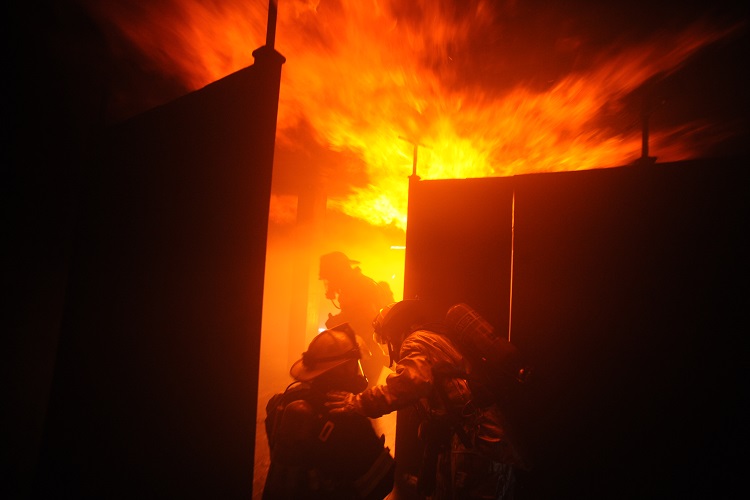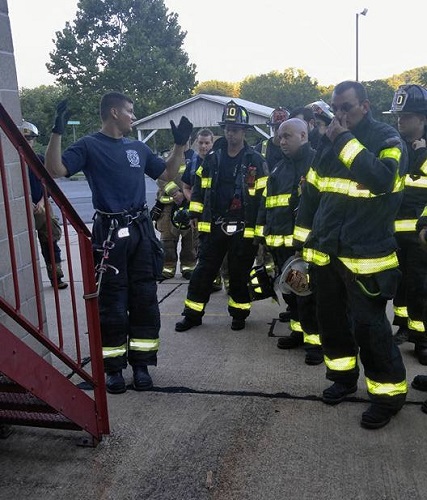
Members of the 106th Rescue Wing’s fire department train on various fire-suppression systems at the Suffolk County Fire Academy in Yaphank, New York, May 9, 2014. (Air National Guard photo by Tech. Sgt. Monica Dalberg.)
By Dennis Walton
A Mayday is an emergency that we all hope we never hear or have to declare. What happens when or if you ever have to respond to one? Does your training kick in, keeping you calm and collected, or are you panicked, rushed, and forgetful of things as conditions continue to deteriorate around you? It seems like every time we open a magazine or read an online blog, we see an article about the latest firefighter Mayday or close call. We have to consider why this is happening.
Buildings are burning hotter and faster because of lightweight construction as well as the chemicals that go into building products and even the everyday items and furniture filling these properties. Also, larger commercial buildings are stretching roof and floor joists across longer distances than ever before, giving the owner optimal floor space.
Subsequently, the technology in our personal protective equipment (PPE) is advancing, protecting us even farther into the buildings and hot conditions. Our self-contained breathing apparatus (SCBAs) now give us a one-third end-of-service alarm instead of the older one-quarter alarm. Are we coming out sooner, or are we staying in longer, knowing the earlier alarm causes us to use air faster as we work through the face piece vibration alert? Staffing continues to slide in career and volunteer fire companies, causing on-scene firefighters to rehab faster and conduct multiple jobs.
All of these factors can possibly lead us to that word: “Mayday.”
What steps can we take to help protect ourselves? We train, train, and train some more (photo 1). We can hit the streets to learn not only our district but surrounding districts in which you may end up. When you check your equipment at the beginning of every shift, do you wear structural fire gloves? If not, consider adding this step to your daily check. Train on and know your equipment and how you will need it when seconds matter.

(1) Photos 1 and 2 by author.
We have all been through or read about firefighter survival and Mayday training. For the most part, every program includes the acronym LUNAR (the Location, Unit, Name, Air supply, Resources needed for your rescue). This is a great resource when the time allows when you are trapped in a collapse with no other hazards. However, in the heat of the moment, are you prepared to take the time to remember all of this and clearly state it to command, or is it time to consider what is really needed as you are heading to the window?
RELATED FIREFIGHTER TRAINING
Stroud on Mayday: Basic Concepts
Caroll on Mayday Monday: Calling the Mayday
As I stated, knowing your equipment is key. Does your portable radio have an emergency button? Once you push the button, what happens? In my city of employment, we have an emergency button that, once pressed, opens the channel for 15 seconds to say whatever we need to without pushing any other buttons, such as having to hold the mic open. That also means we have just 15 seconds to give the LUNAR report, and hope someone wrote it all down.
Why not trim it back a bit? The fire service loves acronyms, so let’s try NOW (Name, Operation, Where). This tells command or the communications center who is in trouble, what he was supposed to be doing on the scene, and where he might be in the building or what window he was going to. You can do this during the 30 seconds of open air and while searching or making your way to the nearest window, or even bailing out of the window.
When it comes to being trapped with no other way out, we train on our breathing. We have to do everything possible to get every second of air out of the cylinder. In the same survival programs, you learn “skip breathing”; this is a great technique and can stretch out your air supply as long as you focus on breathing.
Another technique to try involves turning the cylinder on and off at the valve while you breathe: take a breath in while you turn the cylinder on just to the point that the face piece vibration alert activates, then turn the cylinder off and breath out. Doing this will save air from completely activating the vibration, buying you a few more breaths when needed. It will also keep you focused on what you are doing and possibly help slow down your breathing.
One of the most important rescue components of the SCBA that you should be well trained on is the buddy breathing line. During your daily operations checks, consider inspecting this system. Stretch the line out to see how it deploys and where it is located in case the time ever comes that you need it. You may also find that this gets the leftover debris out of the pouch from the last overhaul assignment.
For your own safety, an important part of your PPE should be a personal rescue rope (photo 2). There are many homemade options and manufactured systems on the market. Each has its own design and deployment advantages, but they are all meant to get you out of danger without jumping.

(2)
Once you own a system, it goes back to one basic training axiom—even the most advanced product doesn’t do much good if it’s just sitting in your pocket. You can do a system check each shift without putting stress and a full load onto the system. Pull the descending device from your pocket to get into the habit of knowing where it is located and how it will deploy. Practice wrapping or hooking the end of the rope onto an object as you would when you need to bail; the muscle memory when you’re calm and can see will save you when you’re anxious and blinded.
RELATED FIREFIGHTER TRAINING
RIT Activation and Firefighter Optimization
Radio Messaging Under Warlike Conditions
Your Ability to Call a Mayday Depends on How You Wear Your Radio
Proper Breathing for the Proper Response
No one can promise that you will never hear a Mayday again, perhaps even from yourself. The best prevention—and chance for survival—is training and discipline. Don’t be afraid to try new techniques or ideas. Keep your mind open to new thoughts; it might just save you in the end.
Author’s Note: Special thanks to Ed Gleason.
In loving memory, EJ Mascaro.
 Dennis Walton is a career firefighter with the Allentown (PA) Fire Department. He is also an instructor for On Scene Training Associates and the Pennsylvania State Fire Academy.
Dennis Walton is a career firefighter with the Allentown (PA) Fire Department. He is also an instructor for On Scene Training Associates and the Pennsylvania State Fire Academy.

